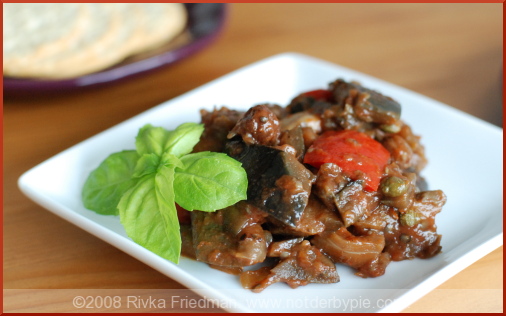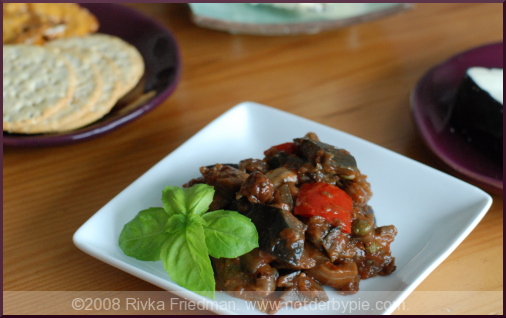
I know I’ve posted caponata on the blog before, but it’s such a go-to recipe that I’m not surprised to see it up here again. Caponata is easy to make, very flavorful, and a true crowd-pleaser, even among the most carnivorous eaters. I made it this time as my contribution to a potluck lunch at work in honor of a colleague’s last day, and was quite surprised by how popular it was with the meat-lovin crowd. I promised them I’d post the recipe, so even though I’ve already got a caponata recipe on the blog, here’s one more.

This one takes its inspiration from a favorite dish that my mom used to make, called Huachinango a la Veracruzana, or Red Snapper, Veracruz style. It’s essentially a whole red snapper (we used filets), baked in a tomato sauce that’s laced with jalapeno peppers, green olives, capers, and raisins, and spiked with cinnamon. The flavors are assertive but balanced, and the dish is really tasty. I basically substituted eggplant for the snapper, and held the olives but put in some olive juice to lift the other savory flavors. I also had been eating too many jalapenos, so I subbed in chili flakes instead. If you’ve got green olives, they’d go great in this dish. I also browned the tomato paste in its own pan to make its flavor more complex, though that step is totally optional.

One of the best things about a chunky caponata like this one is that in addition to being a dip, to be eaten on crackers or baguette, it can double as a pasta sauce. I spooned some if it on top of some whole wheat rigatoni and topped it with feta cheese for an easy and tasty lunch.
This caponata also helped break a slightly frustrating cycle where everything coming out of my kitchen was just so-so. I leaned over this caponata pot, smelled its strong tomato and onion aromas, and thought, oh yea. This is gonna be good.
How good? Good enough that I ate it on pasta the next day.

Another Eggplant Caponata Recipe
olive oil, about 1/4 cup
6 garlic cloves
1 onion, coarsely chopped
1/2 tsp cloves
1 tsp cinnamon
1/2 tsp paprika
1/2 tsp chili flakes
1/2 tsp. cumin
1 tsp. coriander seeds, optional
2 eggplants, cubed into 1-inch pieces
2 Tbsp capers
1/2 cup tomato paste
1/3 cup raisins
1 1/2 cups water
several leaves chopped fresh basil, optional
1 tsp dried italian spices (basil, oregano, etc) — I use Penzeys Tuscan Sunset
1 Tbsp date honey (regular honey is also fine)
1/3 cup green olive juice (can also add 1/3 cup olives, if desired)
1 red bell pepper, coarsely chopped
In a large soup pot, heat olive oil on medium heat. Add onion and garlic; stir to coat, and cook for 3 minutes, or until translucent. Add all spices, toss to coat onions, and cook 2 minutes more. Add eggplant, stir to incorporate, and cook about 5 minutes until eggplant starts to soften and brown in spots.
(If you want to brown the tomato paste in a separate pan before adding to caponata, do so now. Put tomato paste in a small pan over medium heat, mush around, and cook about 5 minutes, until the bottom of the pan starts to turn brown. Add 1/2 cup water and, using a wooden spoon, scrape up the brown bits (called fond) into the tomato liquid. When all the fond has been incorporated into the tomato liquid, add the whole thing into the caponata along with the remaining 1 cup water. If not browning tomato paste, simply add it and all the water to the caponata. Stir to incorporate.
Add all remaining ingredients except for red pepper, stir to combine, and allow to simmer over medium-low heat for about 45 minutes, until well-incorporated. Now — here’s the tricky part — taste it. Does it need more salt? More spice? Is the sweetness of the raisins and honey coming through enough for your taste? Add with a light hand in whatever direction you see fit, and continue to taste and adjust until what’s in the pot makes you happy. Then add the red pepper pieces, and cook 15 minutes more.
Caponata will keep for at least 1 week stored in an airtight container in the fridge.
Comments on this entry are closed.
Nice looking caponata!